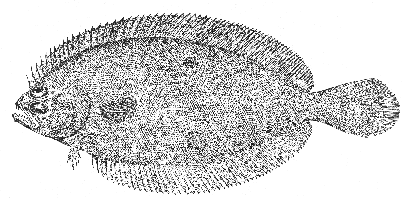Four-spotted flounder Paralichthys oblongus (Mitchill) 1815
[Jordan and Evermann, 1896-1900, p. 2632.]
Description—
This flatfish resembles the summer flounder (p. 267) so closely in its general make-up that we need mention only the points of difference. Most apparent of these are that it has fewer dorsal fin rays (72 to 81 dorsal and 60 to 67 anal rays, contrasted with 85 to 94 and 60 to 73, respectively, in the summer flounder), and that its mottled gray back is invariably marked with four large, oblong, and very conspicuous black eye spots edged with pale pinkish, two of them situated at each margin of the body, as the illustration shows (fig. 135). Incidentally, we have seen two of them on which the lower side, rearward from the gill openings was as dark as the upper side, and marked, similarly, with four eye spots; also others that were more or less dark below.[18]
This is also a much smaller fish than the summer flounder, for the adults average only about 12 inches long with 16 inches as about the maximum.
Habits—
Although this is a rather common fish about Woods Hole in May and June, and is still more numerous along the coast of New York, very little is known of its habits. It does not usually come into as shoal water as the summer flounder often does, being caught most often in 7 to 17 fathoms in Vineyard Sound, for example, near Woods Hole. And the many that have been trawled by the Albatross II and Albatross III between Georges Bank and northern North Carolina, have been generally distributed from about 23 fathoms down to at least 150 fathoms.
[page 271]Its diet is much the same as that of the summer flounder; chiefly small fish and squid, with crabs, shrimps, shellfish, and worms.
It spawns from May until mid-July. The eggs are buoyant, 0.95 to 1.05 mm. in diameter, with a single oil globule of 0.16 to 0.19 mm.[19] The early stages have not been described previously, but certain large mouthed and lefthanded[20] flatfish larvae of 8 to 11 mm. that have been taken in tow nets off New Jersey, by the Grampus in 1913, and from Nantucket Shoals southward by the Albatross II subsequently, seem likely to have been young four-spots, not summer flounders, because they were taken in June and July (p. 269). If this identification is correct, an aggregation of pigment over the rear part of the trunk, combined with deep outline and a large head are distinctive for this species. Small fry of 2 to 3 inches have been taken at Woods Hole in autumn, evidence that the fry of this flounder complete their metamorphosis and take to bottom about 3 months after they are hatched.
General range—
This flounder has been taken between the eastern part of Georges Bank and the coast of South Carolina.[21] Its center of abundance appears to lie between southern New England and Delaware Bay.
Occurrence in the Gulf of Maine—
The four-spotted flounder is so plentiful along the continental shelf as far eastward as the general offing of Nantucket, and to the neighboring part of Georges Bank that we counted about 1,800 of them trawled there, by the Eugene H in 56 hauls at 47 to 67 fathoms, January 27 to February 3, 1950, also 968 of them on the southwestern part of Georges, in 26 to 75 fathoms, in late June 1951. And a few were trawled in 1931 by the Albatross II also along the southern and southeastern parts of Georges Bank. But this last is their most easterly known outpost.
The only records for the four-spot in the coastal waters of our Gulf are from Monomoy at the southern angle of Cape Cod; from the vicinity of Provincetown (where Storer saw a number of them in June 1847); and from somewhere on the northern shore of Massachusetts Bay where one was taken by the United States Fish Commission in 1878.[22]
This is a fair table fish but there is no market for it at present.
[18] Fish trawled by the Eugene H off Marthas Vineyard, Jan. 27 to Feb. 3, 1950, at 47 to 67 fathoms.
[19] Eggs artificially fertilized by 0. E. Sette of the Bureau of Fisheries.
[20] Lefthandness foreshadowed in the larger ones by the fact that it is the right eye that had begun to migrate.
[21] The most southerly record for it is for five specimens trawled in the general offing of Charleston, S. C., lat. 33° 00' N., long. 77°44' W., at 92 fathoms, by Albatross III, January 30, 1950. Another flounder, Ancylopsetta quadrocellata Gill, similar in appearance, for it is strikingly marked with four large spots, is found along the South Atlantic and Gulf coasts.
[22] In one paper (Am. Jour. Sci., Ser. 3, vol. 17, 1879, p. 40) Goode and Bean state that this specimen was trawled in Gloucester Harbor; in another paper (Bull. Essex Inst., vol. 11, 1879, p. 7) they credit it to the mouth of Salem Harbor.
